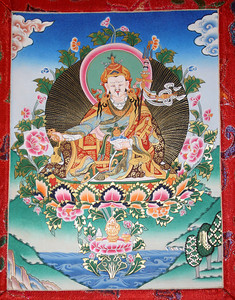An excerpt from a teaching by Jetsunma Ahkon Lhamo called Turning Adversity Into Felicity
When we practice Guru Yoga, we actually begin to develop the view that the lama is the source of liberation. We begin to understand using traditional, prescribed images. For instance, we are taught that we should think of samsara as being like a burning room. In samsara there is a great deal of suffering, and it’s actually just as probable that you will experience adversity as it is probable that you will experience felicity. It is just as probable that you will experience suffering as it is that you will experience happiness and joy. So we think of samsara as being untrustworthy, and we think—and this is true—that within samsara, because of our confusion and our lack of awareness about what our nature actually is, we are constantly giving rise to the causes for more suffering. This is constantly the case. So we think of samsara as being like a burning room with no windows, that there is no escape except for this one door. In our practice we think that the Lama is like that door.
The Lama is considered to be the door to liberation, the very means by which the blessing comes to us. Without the Lama, we would not have been hooked onto the path. Without the Lama, we would not receive the teaching. Without the Lama, we would not understand the teaching. Without the Lama, our minds would not be empowered and ripened and matured. That is the responsibility of the relationship between the guru and disciple. The mind must be matured in order to progress on the path. So we rely on the Lama for all of these things without which we remain wandering in samsara experiencing birth/death/birth/death/birth/death with very little control.
Of course, when life is going well we think that this must not be true. It looks like we have a lot of control in our life. But if you think that, then you should read the newspaper more frequently, and you should talk to people who have been inflicted with incurable, diseases, who were afflicted completely out of the blue, not expecting that their lives would come to this. You should talk to people who have suffered through circumstances that seemed to come from outside, misfortune, the loss of a job, the loss of loved ones. These are terrible sufferings for us as human beings, and until we have experienced our fair share of them — and we will, eventually; old age, sickness and death, these things occur to all of us — we have the delusion of a certain kind of control in our life. Ordinarily that kind of delusion comes with youth, and then later on, as we pass the age of supreme omniscience at about 30, we begin to discover that, in fact, we are not totally in control, that life seems to control us.
So we think of samsara as being this untrustworthy, inescapable difficulty, and we think of the lama as being the door to liberation. We hold that kind of regard. It isn’t that we worship a personality. Of course, it’s not like that. That would be very superficial and useless. What good is a personality? If we conceive of the Lama as a personality, what good would that do us? We are a personality, and look where it’s gotten us! That’s nothing to rely on. So we rely on the Guru as the condensed essence of all the objects of refuge: all the Buddhas, all the Bodhisattvas, all the Lamas, all the meditational Deities, the Dakinis and the Dharma protectors all rolled into one, including all of the teachings. These are the liberating truths of Dharma. These are the objects of refuge. So the Lama becomes the door through which we exit samsara.
© Jetsunma Ahkön Lhamo











